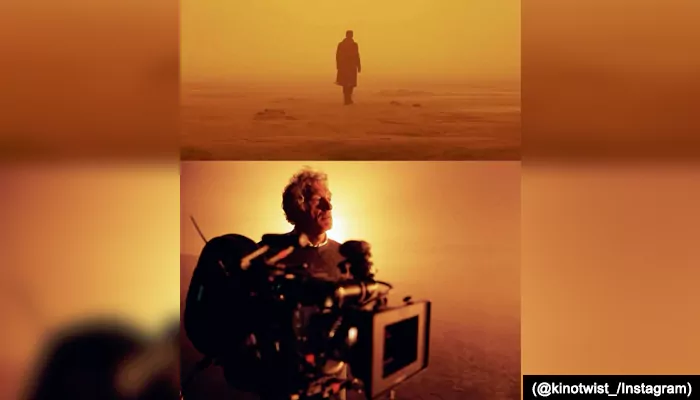
For World Photography Day 2025, let's ditch the selfies and dive into movies where the lens wasn't just recording, it was telling the story. Get ready for some serious cinematic eye candy!
World Photography Day rolls around again! It’s that awesome day we tip our hats to the art of capturing light and life. But instead of just scrolling through Instagram feeds (guilty as charged!), let's talk about moments when the camera in a film became way more than just a fancy recorder. It became a character, a storyteller, a mind reader! Think of it as the camera putting on its director's hat and whispering secrets directly to your eyeballs.
We’re talking Hollywood and Bollywood, because magic lenses know no borders. Ready? Lights out, projector on!
(@cnmddct/Instagram)
Alfred Hitchcock basically locked James Stewart in an apartment with a broken leg and a killer telephoto lens. Sounds grim? It’s genius! Every single shot in this film is literally from Jeff’s (Stewart) window. We see only what he sees, squinting across the courtyard. That camera isn’t just showing us suspicious neighbors; it’s making us feel Jeff’s itchy curiosity, his helplessness, his growing dread. We’re sweating bullets right alongside him, glued to that viewfinder. Talk about immersive!
(@bb69_channel/Instagram)
Okay, yeah, the bullet-dodging scene. Iconic. But remember why it blew our minds? The Wachowskis and cinematographer Bill Pope didn't just film Keanu Reeves leaning back. They invented "bullet time" - freezing the action while the camera whips around in a breathtaking arc. Suddenly, the camera wasn't bound by physics! It showed us the impossible, making Neo’s superhuman perception our reality. It was the camera saying, "Hold my beer, reality, we're bending the rules today." Pure visual adrenaline that changed action films forever (even if the tech feels like a Nokia 3310 in 2025!).
Raging Bull (1980) Dir Martin Scorsese
— BJA Samuel (@bja_samuel) July 22, 2021
“It’s not just how the camera moves, it’s the emotion that it shows,” -Thelma Schoonmaker
The camera drifts around the ring in the aftermath of the fight, Jake's blood drips from the rope. This entertainment costs blood.#filmtwitter pic.twitter.com/zkZp5If0oV
(@bja_samuel/X)
Martin Scorsese and cinematographer Michael Chapman turned a boxing ring into a brutal ballet. Forget slick, clean shots. For Jake LaMotta’s fights, the camera gets in the ring. It bobs, weaves, gets splattered with sweat and blood. We hear the thud of gloves, feel the sting of the spotlight, and gasp for air with the fighters. It’s not pretty; it’s visceral. The camera becomes Jake’s rage and confusion, making the violence feel terrifyingly intimate. You don’t just watch the fight; you survive it. Powerful stuff.
(@dozokhnama/Instagram)
Anurag Kashyap’s wild, modern take on Devdas ditched the traditional grandeur for something raw and trippy. Cinematographer Rajeev Ravi’s camera went full-on kaleidoscope for Dev’s descent. Think distorted lenses, crazy colours bleeding everywhere, frantic shaky-cam during his binges. It wasn’t just showing his messed-up state; the camera felt it. The blurry edges, the jarring angles – you were right there in his chaotic headspace. It made heartbreak look like a bad, beautiful acid trip. Definitely not your average Bollywood romance lighting!
(@philosophical.core/Instagram)
Vishal Bhardwaj’s Hamlet adaptation set in conflict-ridden Kashmir is visually stunning and deeply unsettling. Cinematographer Pankaj Kumar didn’t just capture the breathtaking, snow-covered landscape; he weaponized it. That crisp, almost painfully clear winter light? It felt like it exposed every secret, every lie. Wide shots emphasized the characters' isolation amidst political turmoil. Tight close-ups trapped us in Haider’s haunted eyes. The camera became a silent observer of the pervasive fear and beauty, making the setting a living, breathing character pressing down on everyone. Masterful, chilling work.
These films remind us that photography – whether capturing a single moment or moving through a story – is about perspective. It’s about how you see, not just what you see. The camera lens shapes emotion, builds tension, reveals hidden truths, and even warps reality. It’s the ultimate tool for showing us the world through someone else’s eyes (or paranoia, or heartbreak, or super-speed!).
So, this World Photography Day, grab your phone, your DSLR, or even just your own two eyes. Look for the story in the frame. Find that unique angle. Make people feel something, not just see it. Because the best images, like the best films, linger long after the shutter clicks or the credits roll. Now that’s worth celebrating. Go capture some magic!